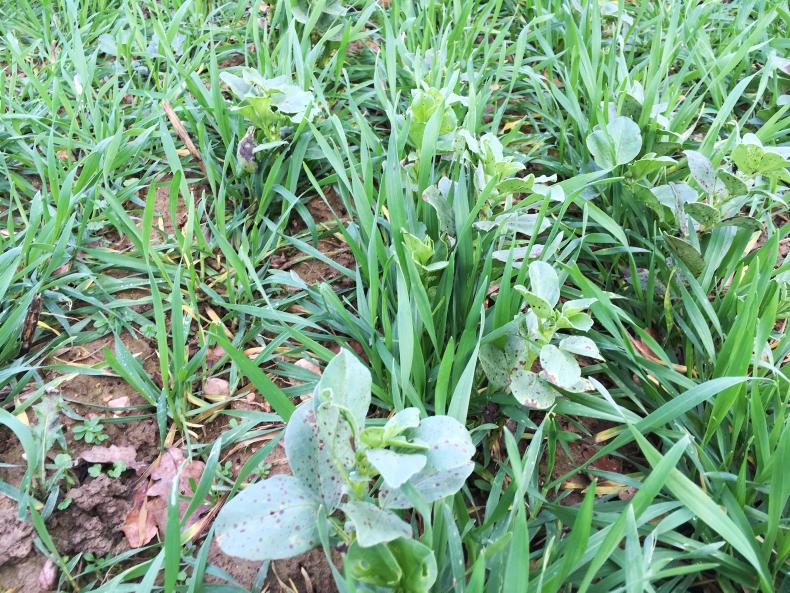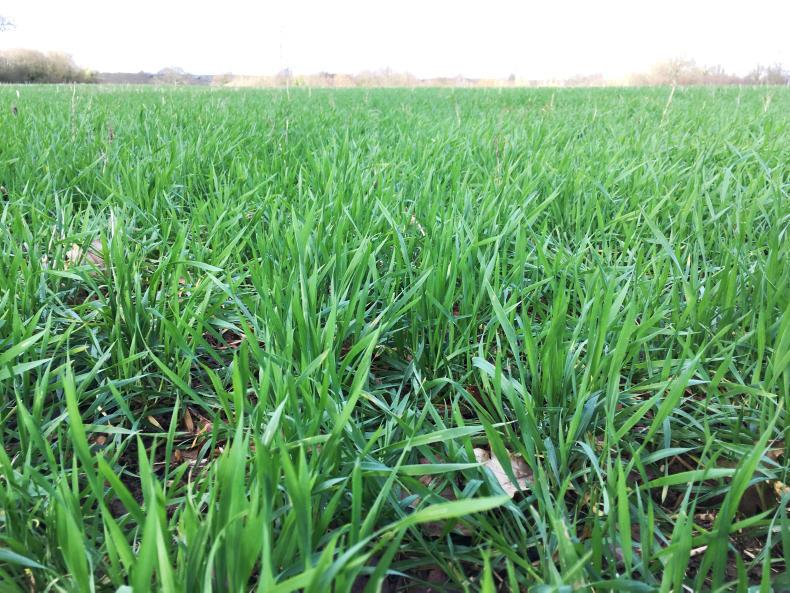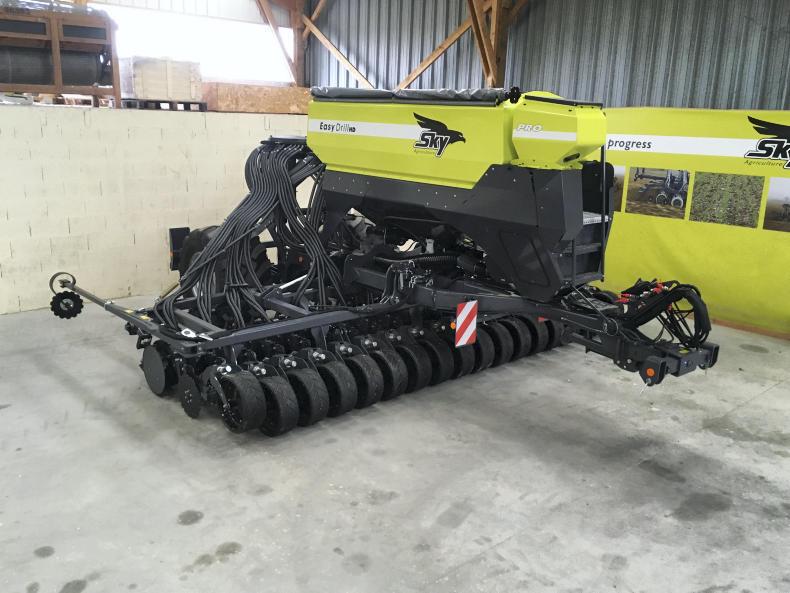The age of finding the answer in a can is well and truly over. No group of farmers realises this more than the French, explains Christophe DeCarville, chief product manager at Sky Agriculture, on a recent visit to the Ferme de la Conillais in France.
The 170ha farm in the east of the country is used a research centre for Sky Agriculture, a sister company of Sulky. The company was established in 2013 to deliver direct-drilling solutions for French farmers and whose drills continue to grow in popularity.
Last month, a group of Irish farmers visited the farm and had the chance to see the latest tillage farming practices which are proving a success for farmers in the area.
Direct-drilling
The farm produces cereals, oilseeds and legumes and is owned and managed by Sky’s founder and managing director David Guy. Half of the farm is currently organic and had traditionally used a plough, till, sow system.
However, after growing tired of the workload, high costs and damage to the soil structure, David made the decision to begin the process of converting to a min-till system. Unhappy with minimum tillage, David began the journey of developing a direct-drilling system which would work on his farm.
Many mistakes were made and it has been a learning curve, explains David, but once a system suited to his farm was developed, the direct-drill approach proved highly beneficial.
Companion cropping
Companion cropping is in its infancy in Ireland, with only a handful of organic growers practising the system. However, the technique is widely practised in certain regions of France, both on conventional and organic farms.
Companion cropping is a system of cultivation which involves establishing two or more crops simultaneously. Depending on the market, one or more of those crops are harvested.
It has been claimed by French farmers that, given the optimum mix, companion cropping can deliver benefits such as improved weed control, provide a supply of soil N to the growing and subsequent crop, increase yields and biodiversity, and decrease overall inputs.
Companion crops on David’s farm are established using a Sky Easydrill direct-drill with twin hoppers capable of drilling two crops with one pass.
There are a number of companion cropping mixes used on the farm. One such mix involves drilling winter oilseed rape (WOSR) with spring beans. The beans fix nitrogen, help with weed control and act as a deterrent for pigeons. The beans then die off with the onset of frost in winter.
Arguably the most widely used companion cropping mix in France is WOSR and white clover. Between 2kg/ha and 3kg/ha of white clover is sown alongside rape at a cost of approximately €20/ha.
The white clover variety Aberace is commonly used as it germinates and grows quickly.
According to David, the variety quickly outcompetes many weeds without interfering with the establishment or yield of the oilseed rape.
When the oilseed rape is harvested (without desiccation), the cover crop (white clover) is already established and growing.
The following crop of winter wheat is drilled directly into the clover. Shortly after drilling, the white clover is killed with a selective herbicide before the wheat seedling emerges.
The nitrogen-fixing properties of clover provide the soil with a steady supply of organic N for the winter wheat crop. This practice has led to a staggering reduction of 100 units of chemical N/ha for first wheat crops on David’s farm.
Cover cropping
As well as companion cropping, cover crops play a central role in the farm’s rotation and this, according to Christophe, is the missing link when deciding to switch to a direct-drilling system.
All crops are drilled directly into cover crops which are killed off one to two days after drilling. The established cover crop acts as natural barrier for weeds and provides a source of feed for earthworm populations. Having a healthy and vibrant worm population helps to create natural drainage channels throughout the soil.
“There is a straight relationship between the quantity of worms you have in the field and the quantity of water you can drain from the field,” explains Christophe. This is an important factor in determining the success of direct drilling.
Growing a good cover crop can be tricky in Ireland because of the relatively late harvest when compared with France. In an effort to address this, Christophe suggested broadcasting a cover crop mix two to three weeks before harvest (where pre-harvest glyphosate isn’t used) using a fertiliser spreader.
In theory, when the crop is harvested, the cover crop will already be established and growing. None of the growers on the trip had seen this method practised in Ireland before but it may be worth experimenting in the fields this coming season.
Cover cropping
“If you’re happy with the way things are, then don’t change, but if you aren’t then you’ll have to try new things,” explains Christophe.
He proceeded to explain that they had made many mistakes throughout the development of their cropping system.
However, through a number or years of trial and error, experimenting with crops, timings and varieties, they eventually found a system that works. This poses the question, could a system similar to this, but specifically designed for Irish climates, be developed here? One which addresses the issues of soil health, water infiltration, machinery and input costs while contributing to increasing our output and reducing our reliance on pesticides. One thing is for certain, we will never know unless we try.
Direct-drilling is a whole farm systems approach.Companion cropping delivers benefits in terms of increased soil N and reduced inputs. Cover crops play an important role in direct-drilling systems.
The age of finding the answer in a can is well and truly over. No group of farmers realises this more than the French, explains Christophe DeCarville, chief product manager at Sky Agriculture, on a recent visit to the Ferme de la Conillais in France.
The 170ha farm in the east of the country is used a research centre for Sky Agriculture, a sister company of Sulky. The company was established in 2013 to deliver direct-drilling solutions for French farmers and whose drills continue to grow in popularity.
Last month, a group of Irish farmers visited the farm and had the chance to see the latest tillage farming practices which are proving a success for farmers in the area.
Direct-drilling
The farm produces cereals, oilseeds and legumes and is owned and managed by Sky’s founder and managing director David Guy. Half of the farm is currently organic and had traditionally used a plough, till, sow system.
However, after growing tired of the workload, high costs and damage to the soil structure, David made the decision to begin the process of converting to a min-till system. Unhappy with minimum tillage, David began the journey of developing a direct-drilling system which would work on his farm.
Many mistakes were made and it has been a learning curve, explains David, but once a system suited to his farm was developed, the direct-drill approach proved highly beneficial.
Companion cropping
Companion cropping is in its infancy in Ireland, with only a handful of organic growers practising the system. However, the technique is widely practised in certain regions of France, both on conventional and organic farms.
Companion cropping is a system of cultivation which involves establishing two or more crops simultaneously. Depending on the market, one or more of those crops are harvested.
It has been claimed by French farmers that, given the optimum mix, companion cropping can deliver benefits such as improved weed control, provide a supply of soil N to the growing and subsequent crop, increase yields and biodiversity, and decrease overall inputs.
Companion crops on David’s farm are established using a Sky Easydrill direct-drill with twin hoppers capable of drilling two crops with one pass.
There are a number of companion cropping mixes used on the farm. One such mix involves drilling winter oilseed rape (WOSR) with spring beans. The beans fix nitrogen, help with weed control and act as a deterrent for pigeons. The beans then die off with the onset of frost in winter.
Arguably the most widely used companion cropping mix in France is WOSR and white clover. Between 2kg/ha and 3kg/ha of white clover is sown alongside rape at a cost of approximately €20/ha.
The white clover variety Aberace is commonly used as it germinates and grows quickly.
According to David, the variety quickly outcompetes many weeds without interfering with the establishment or yield of the oilseed rape.
When the oilseed rape is harvested (without desiccation), the cover crop (white clover) is already established and growing.
The following crop of winter wheat is drilled directly into the clover. Shortly after drilling, the white clover is killed with a selective herbicide before the wheat seedling emerges.
The nitrogen-fixing properties of clover provide the soil with a steady supply of organic N for the winter wheat crop. This practice has led to a staggering reduction of 100 units of chemical N/ha for first wheat crops on David’s farm.
Cover cropping
As well as companion cropping, cover crops play a central role in the farm’s rotation and this, according to Christophe, is the missing link when deciding to switch to a direct-drilling system.
All crops are drilled directly into cover crops which are killed off one to two days after drilling. The established cover crop acts as natural barrier for weeds and provides a source of feed for earthworm populations. Having a healthy and vibrant worm population helps to create natural drainage channels throughout the soil.
“There is a straight relationship between the quantity of worms you have in the field and the quantity of water you can drain from the field,” explains Christophe. This is an important factor in determining the success of direct drilling.
Growing a good cover crop can be tricky in Ireland because of the relatively late harvest when compared with France. In an effort to address this, Christophe suggested broadcasting a cover crop mix two to three weeks before harvest (where pre-harvest glyphosate isn’t used) using a fertiliser spreader.
In theory, when the crop is harvested, the cover crop will already be established and growing. None of the growers on the trip had seen this method practised in Ireland before but it may be worth experimenting in the fields this coming season.
Cover cropping
“If you’re happy with the way things are, then don’t change, but if you aren’t then you’ll have to try new things,” explains Christophe.
He proceeded to explain that they had made many mistakes throughout the development of their cropping system.
However, through a number or years of trial and error, experimenting with crops, timings and varieties, they eventually found a system that works. This poses the question, could a system similar to this, but specifically designed for Irish climates, be developed here? One which addresses the issues of soil health, water infiltration, machinery and input costs while contributing to increasing our output and reducing our reliance on pesticides. One thing is for certain, we will never know unless we try.
Direct-drilling is a whole farm systems approach.Companion cropping delivers benefits in terms of increased soil N and reduced inputs. Cover crops play an important role in direct-drilling systems. 





 This is a subscriber-only article
This is a subscriber-only article


















SHARING OPTIONS: